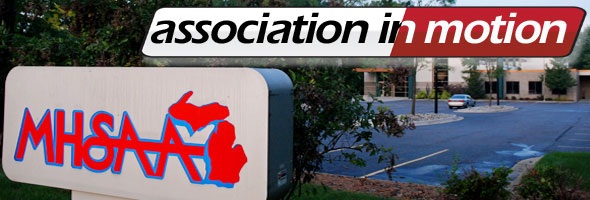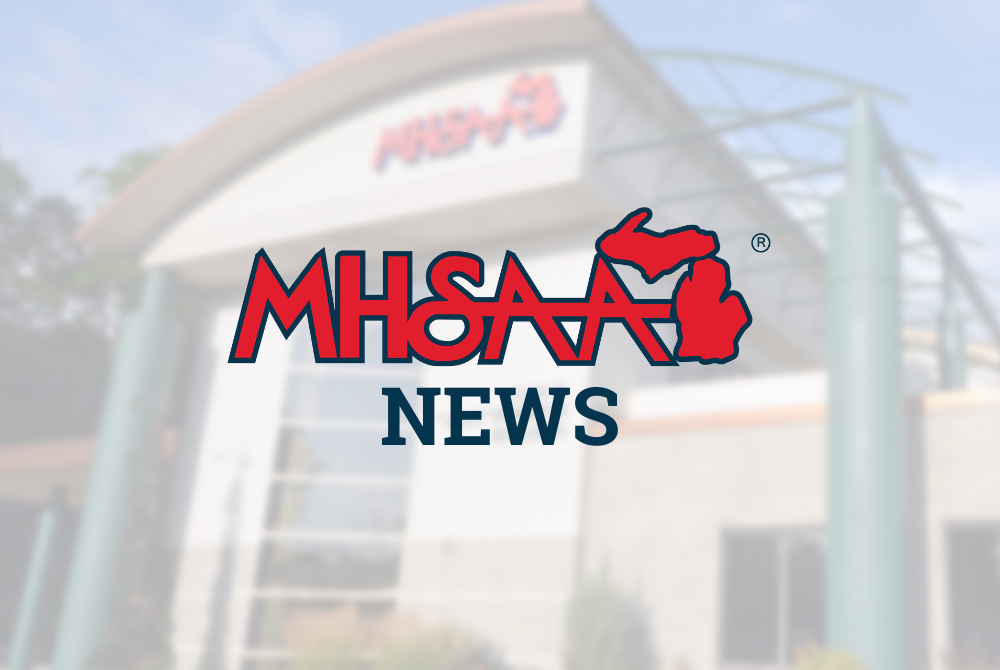
MHSAA Provides Reopening Guidelines
May 29, 2020
By Geoff Kimmerly
Second Half editor
The Michigan High School Athletic Association today submitted to its member schools a series of updated timelines and recommendations to guide the return of sports, which have been suspended since mid-March to alleviate the potential spread of COVID-19.
The state’s current “Safer-at-Home” order runs through Friday, June 12. There can be no use of any school facilities (indoor and outdoor) and there can be no organized on-site athletic activity, including conditioning or competition, until the current stay-at-home order expires or is lifted by Governor Gretchen Whitmer. When the “Safer-at-Home” order expires or is lifted, the return-to-activity recommendations may be implemented locally by school district leadership, provided the district declares its facilities open to students and staff and the 2019-20 school year has ended for that district (based on its last originally-scheduled school day).
The “MHSAA/NFHS Guidance for Re-Opening School Sports” is based primarily on direction provided by the MHSAA and National Federation of State High School Associations’ (NFHS) Sports Medicine Advisory Committees, in addition to reopening plans provided by the Michigan and federal governments and recommendations from the Center for Disease Control and Prevention (CDC). Concepts from the United States Olympic & Paralympic Committee also were consulted.
The MHSAA/NFHS plan recommends a three-step process to returning to full athletic participation, and for each step outlines actions to be taken in five major areas: pre-workout/contest screening of athletes and coaches for sickness, limitations of the number of participants who may be involved in a gathering, proper cleaning for facilities, the use of equipment during activity and best practices for keeping participants safely hydrated. The plan also places sports into categories based on risk for transmitting the virus (low/moderate/high), with adjusted return-to-activity steps based on that level of risk.
The MHSAA serves more than 1,500 public and private schools, including 750 high schools.
“The MHSAA and its Representative Council believe restarting school sports is essential to the physical and mental well-being of students, and the guidelines outlined for schools today provide the ‘How’ for schools to return to athletics when they’ve received the go-ahead from state and county health officials,” MHSAA Executive Director Mark Uyl said. “We are thankful for our state government, state education and health departments, our medical partners and the NFHS for their guidance these last few months, and we will continue to follow and pass on their recommendations as we prepare our schools to bring back this part of student life that’s been sorely missed.”
At the present time, the only activity allowed continues to be individual, outdoor recreational activity including walking, hiking, running, etc. (as announced in Executive Order 2020-96). If this type of conditioning activity takes place with more than one person present, it must be in groups of fewer than 10 people with social distancing followed, and the activity cannot involve school coaches, be school sponsored or occur at any school facility (indoor or outdoor) until at least June 13.
Voluntary virtual (not in-person) communication and instruction from coaches to any number of students is permitted under MHSAA rules in all sports during the summer.
“The concept is that students can continue to individually condition themselves (by walking, hiking, running), but there should be no organized, group activity by any person until at least June 13. We must all continue do our part to flatten the curve in hopes of increased activity over the coming weeks,” Uyl said. “Again, it is important to note that this document addresses ‘How’ schools can return to activity; the decision on ‘When’ schools can return to activity will be done under the direction of state government and health department officials. As government actions impact this timeline, the MHSAA will continue to update all involved.”
The return-to-activity guidelines are aimed to provide direction for schools as they continue to limit potential exposure to respiratory droplets, the primary avenue for transferring COVID-19. Specifically, the MHSAA/NFHS plan addresses social distancing, use of cloth and other face coverings, event scheduling and transportation, and the possibility that schools may have to break from or completely discontinue activity including competition during the fall or winter because of recurrent outbreaks of the coronavirus.
School district administrators will determine at which step in the MHSAA/NFHS plan their schools are operating based on the number of people allowed to gather by state medical officials.
The document in full is available from the MHSAA Website. Further guidance will be provided over the weeks ahead as new information is available and the prevalence of COVID-19 changes. Updates to the MHSAA/NFHS guidelines will continue to be in accordance with those published by the Governor’s office.
The MHSAA has remained in regular contact with the Governor’s office, Michigan Department of Health & Human Services and Michigan Department of Education throughout the pandemic, in addition to leadership from the state’s superintendents, school principals, athletic administrators and school boards associations.
The MHSAA is a private, not-for-profit corporation of voluntary membership by more than 1,500 public and private senior high schools and junior high/middle schools which exists to develop common rules for athletic eligibility and competition. No government funds or tax dollars support the MHSAA, which was the first such association nationally to not accept membership dues or tournament entry fees from schools. Member schools which enforce these rules are permitted to participate in MHSAA tournaments, which attract more than 1.4 million spectators each year.

Survey Shows Small but Steady Rise of Multi-Sport Participation at MHSAA High Schools
By
Geoff Kimmerly
MHSAA.com senior editor
December 16, 2025
The Michigan High School Athletic Association’s seventh Multi-Sport Participation Survey, conducted last spring for the 2024-25 school year, showed small but continuing growth of multi-sport participation among athletes at member high schools.
The annual Multi-Sport Participation Survey was inspired by the MHSAA’s Task Force on Multi-Sport Participation, which was appointed in 2016 to study early and intense sport specialization – a serious issue related to health and safety at all levels of youth sports – and to promote multi-sport participation as a way to help stave off overuse injuries and burnout among athletes that have been tied to chronic injuries and health-related problems later in life.
The 2024-25 Multi-Sport Participation Survey received responses from 82.7 percent of member high schools and showed 45.4 percent of athletes at those MHSAA member high schools participating in two or more sports, an increase of six tenths of a percent from 2023-24. Multi-sport participation has shown increases every year of the study – and a combined increase of 2.6 percent since the first study after the 2017-18 school year.
For 2024-25, 47.8 percent of male athletes and 42.3 percent of female athletes played multiple sports. The percentage of multi-sport athletes remains inversely proportional to schools’ enrollments, as Class D schools again enjoyed the highest percentage of multi-sport athletes at 63.1 percent, followed by Class C schools (59.6), Class B (49.3) and Class A (38.5).
All four enrollment classifications also continued to show increasing multi-sport participation. Class A multi-sport participation increased three tenths of a percent from 2023-24 and is now up 2.6 percent from 2017-18 survey results. Class B increased 1.3 percent from the previous year and is also up 2.6 percent since 2017-18. Class C multi-sport participation grew two tenths of a percent over the previous year and sits 4.4 percent higher than the first study, and Class D multi-sport participation in 2024-25 remained the same as in 2023-24 and has grown five percent over the last seven years.
The MHSAA Task Force also recommended measuring multi-sport participation in MHSAA member schools to recognize “achievers” – that is, schools that surpass the norm.
Battle Creek Harper Creek, Detroit Cody and Grand Rapids Northview have appeared among the top 10 percent of their respective Classes six of the seven years the survey has been conducted. Four more schools have appeared among the top 10 percent of their Classes five of the seven years: Decatur, East Grand Rapids, Manton and Warren Michigan Collegiate. Detroit Douglass, Parma Western and Lake Leelanau St. Mary have appeared among the top 10 percent of their Classes four times apiece.
In Class A, Grand Rapids Northview (79.4 percent) posted the highest percentage of multi-sport athletes for 2024-25, followed by Macomb L’Anse Creuse North (70 percent), Detroit Cass Tech (61.4) and Sterling Heights Stevenson (60.7) also reporting at least 60 percent.
Warren Michigan Collegiate paced Class B schools with 91.3 percent of athletes playing multiple sports, followed by Tecumseh (77.7), Yale (76.6), Detroit Cody (71.4), Battle Creek Harper Creek (71.3) and Manistee (70.1). Class C saw six schools reach 80 percent for the second-straight school year, led by Jackson Lumen Christi (97.6 percent), Martin (89.7), Bad Axe (89.3), Cass City (88.6), Center Line Prep Academy (83.6) and Decatur (82.3).
Watervliet Grace Christian topped the Class D list at 93.8 percent of athletes participating in multiple sports. Next were Watersmeet (89.7), Lake Leelanau St. Mary (88.2), Detroit Douglass (87.8), Vestaburg (87.7) and Portland St. Patrick (87.3).
The full summary report on the Multi-Sport Participation Survey is available on the “Multi-Sports Benefits” page.

